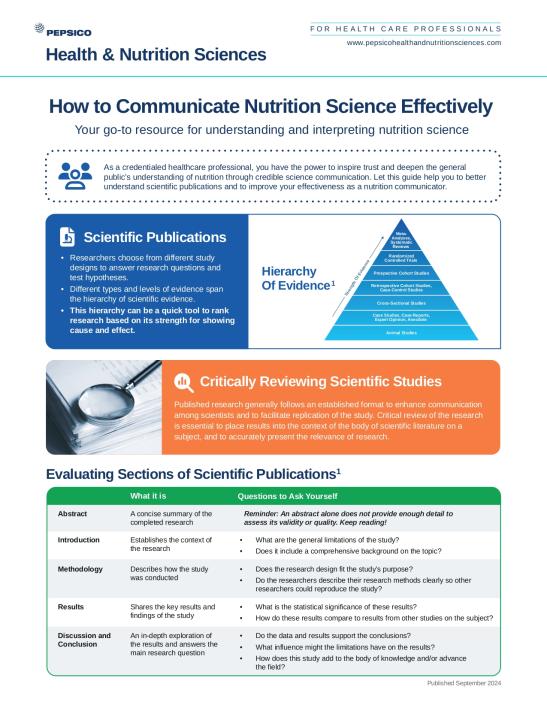How to Communicate Nutrition Science Effectively
Please click on "Click to view" on the image to the right to download this resource to use with your patients and clients!
- How to critically review scientific studies
- Tips for evaluating the quality of scientific studies
- Guidance for communicating nutrition science effectively
How to Communicate Nutrition Science Effectively
As a credentialed healthcare professional, you have the power to inspire trust and deepen the general public’s understanding of nutrition through credible scientific communication. Let this guide help you to better understand scientific publications and to improve your effectiveness as a nutrition communicator.
Reviewing scientific publications and understanding study design
- Researchers choose from different study designs to answer research questions and test hypotheses.
- Different types and levels of evidence span the hierarchy of scientific evidence. Download the handout to learn about this hierarchy.
Published research generally follows an established format to enhance communication among scientists and to facilitate replication of the study. Critical review of the research is essential to place results into the context of the body of scientific literature on a subject, and to accurately present the relevance of research.
What are the sections of a scientific paper?
- Abstract: A concise summary of the completed research
- Introduction: Establishes the context of the research
- Methodology: Describes how the study was conducted
- Results: Shares the key results and findings of the study
- Discussion and Conclusion: An in-depth exploration of the results and answers the main research question.
Download the handout to the right to learn the questions to ask yourself as you’re evaluating new scientific publications.
What are some signs of high-quality and poor-quality science?
Signs of high-quality science:
- The research is published in a reputable, peer-reviewed journal
- The results are drawn from the totality of evidence, rather than just this one study
- The authors disclosed any conflicts of interest clearly
- The research considers the broader ethical questions and societal implications of the study findings
- The study discusses limitations and accounts for confounding factors
Signs of poor-quality science:
- Claims that sound too good to be true
- Lists of “good” or “bad” foods
- Recommendations made to help sell a product
- Recommendations based on studies published without peer review
- Dramatic statements that are discredited by reputable scientific organizations
Tips to Translate and Communicate Science Effectively
Science is a process, with the research cycle frequently moving in many different directions, generating questions, discussions, and debates along the way. This makes it challenging for communicators to share credible content in a timely manner.
Tips to Keep in Mind
- Consider all parts of the study publication, from abstract, introduction, methodology, results, discussion, and conclusions, and ask the key questions posed above.
- Reserve judgment about a study until consulting other studies and appropriate experts to help assess the findings of the study and gauge its level of importance.
- Discuss and debate the paper with trusted colleagues.
- Consider contacting scientists familiar with the topic (or even reaching out to the study authors themselves) and ask how this study fits with the body of research.
- Communicate what is known from the study as well as the broader literature, and then provide credible, actionable content.
- If the current paper confirms previous research or departs from current thinking, the communicator’s role is to put all research into context for the general public.
- Remember not to overstate the study findings beyond the population studied or to exaggerate conclusions beyond what is statistically significant or relevant for public health.
Please click on "Click to view" or on the image to the right to download this resource to learn more about how to communicate nutrition science effectively to your patients, clients and the general public.
References
- IFIC. (2024). Understanding & Interpreting Food & Health Scientific Studies: Guidance For Food & Nutrition Communicators. Retrieved 2024, from https://foodinsight.org/wp-content/uploads/2024/03/IFIC-Science Communication-Guidance-Document.pdf.
